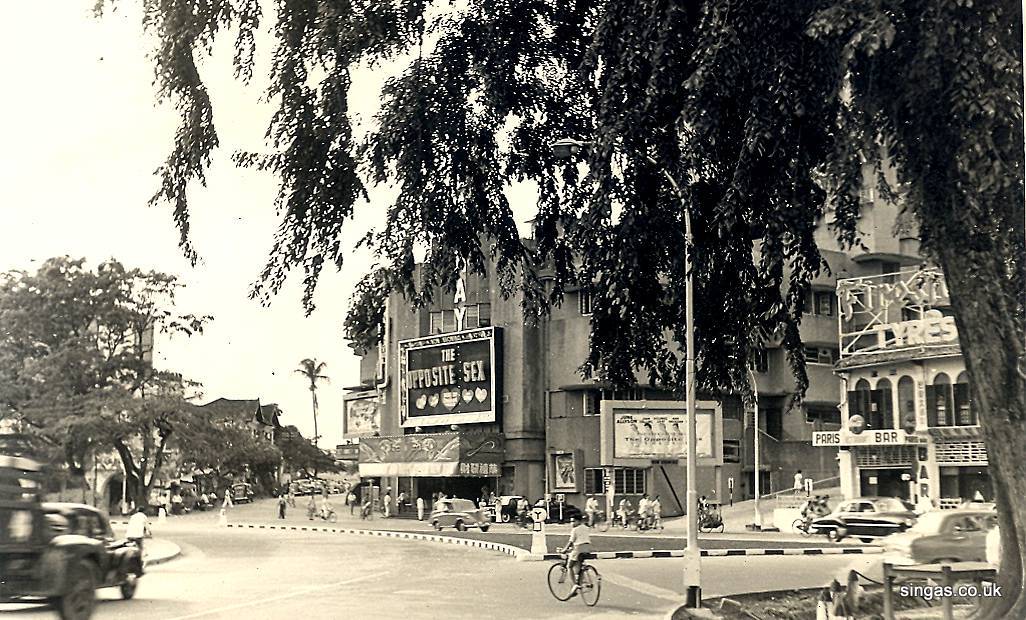1. What’s In A Name?
Orchard Road was named after the numerous nutmeg farms, pepper farms, spice gardens and fruit orchards that covered the area since the 1830s. Some sources also point to a mysterious Mr Orchard who owned plantations at the corner of Scotts and Orchard Road. The plantations started to disappear in the 1960s because of falling nutmeg prices and disease.
 Source. Nutmeg And Mace by Kumari Nahappan, commissioned by Ion Orchard.
Source. Nutmeg And Mace by Kumari Nahappan, commissioned by Ion Orchard.
2. Ponding Since The 1840s
As Orchard Road lies in a depression, the area was susceptible to frequent floods as early as the 1840s. This continued until the 1960s when Orchard Road received a proper drainage system makeover. In 2010, in response to freak flash floods, the road was raised by an average of 300mm as an additional flood prevention measure.
 Source. Orchard Road flood, 1960s
Source. Orchard Road flood, 1960s
3. Bombs & Body Parts
No glitzy locale would be complete without that tiny touch of gore. Orchard Road has seen it’s fair share of shock. Top of the list would be the infamous MacDonald House bombing on 10th March 1965. Perpetrated by Indonesian commandos during the Konfrontasi, it was the most devastating of the the 42 bombs that were set off during that time - 3 were killed and at least 33 others were injured.
"> " width="560" height="315" frameborder="0" allowfullscreen="allowfullscreen">
Orchard Road also found itself to be quite the body-part magnet. In the 1984 Curry Murder, Ayakanno Marimuthu was beaten to death, cut into pieces and cooked in curry at the Orchard Road Presbyterian Church. His remains were never found.
In 2005, Filipina Guen Garlejo Aguilar murdered fellow Filipina Jane Parangan La Puebla, chopped her into bits and left them in bags at Orchard Road and MacRitchie Reservoir. The motive? Over $2000. Guess she didn’t get her cash back.
4. Forgotten Places
CK Tangs
One of the oldest and first departmental stores to operate on Orchard Road, Tangs was build by Tang Choon Keng who first started out his business selling embroidered linens door-to-door. As his business grew, he bought the plot of land at the corner of Orchard and Scotts Road in 1958 and built the third iteration of the House of Tang. The distinctive green green roof tiles and red pillars were modelled after the Imperial Palace in Beijing.
 Source. C.K. Tangs
Source. C.K. Tangs
 Source. C.K. Tangs at Christmas time
Source. C.K. Tangs at Christmas time
Orchard Road Market
Orchard Road Market occupied the site of what is now Orchard Point. Opened in 1891, the market became a popular place for housewives to get fresh produce. The original six metre tall cast iron fountain in front of the market was restored and now sits in the Raffles Hotel courtyard.
 Source. Before Fendi, there was fish.
Source. Before Fendi, there was fish.
Orchard Road Carpark Hawker Centre - Gluttons Square
 Source. NEA’s nightmare
Source. NEA’s nightmare
Situated on what is currently Orchard Central, the Orchard Road Carpark (or Glutton’s Square) was the place to be for under-a-dollar oyster omelette and char kway teow. Hawkers would wait till the open-air car park closed at 5pm before flying in to set up their stalls. At one time, there were 80 stalls operating from the carpark, with each parking lot holding 2 stalls. The overcrowded smorgasbord of local delights was unfortunately closed in 1978.
 Source. Glutton’s Square
Source. Glutton’s Square
Fitzpatrick’s Supermarket
Opened on August 9th 1958, Fitzpatrick’s occupied what is present day Paragon. It was the first to operate a supermarket system in which buyers browsed long shelves of goods while pushing around a trolley cart and helped themselves to the goods they wanted. Designed with an upmarket clientele in mind, the supermarket featured the holy triad of consumer comfort: valet parking, automatic doors, and air-conditioning.
 Source. Fitzpatrick Supermarket
Source. Fitzpatrick Supermarket
 Source. Fitzpatrick Supermarket, 1969
Source. Fitzpatrick Supermarket, 1969
Interesting Fact: During the 1974 World Cup final between Germany and Holland, football fans camped at the Fitzpatrick’s carpark where it was screened in colour.
 Source. World Cup mania
Source. World Cup mania
5. I (Don’t) See Dead People
3 prominent graveyards were situated along Orchard Road in the 1840s. There was a Chinese cemetery located at present-day Ngee Ann City, a Sumatran graveyard behind today’s Concorde Hotel, as well as a Jewish cemetery at the current Dhoby Ghaut MRT Station.
6. SG Swinging
Long before Orchard Road saw the heaving, squeezing mass that was Pedestrian Night, it was assaulted by Swing Singapore. Starting as a street party in 1988, Swing Singapore was an excuse to club for free opportunity for people to let their hair down at what was Singapore’s largest outdoor party ever. The first Swing Singapore event saw a turnout of 250,000 participants, and enough power to power 50 discos and light up 400 HDB flats.
 Source. Swinging it.
Source. Swinging it.
7. Railway Ride
Before the construction of the Tanjong Pagar Railway Station, trains travelled from Tank Road Terminal to Bukit Timah Railway Station via Cuppage Road. This set of tracks was dismantled in 1932 when Tanjong Pagar station was up and running. It was said that whenever the train thundered above Orchard Road, the people below would stop because it was considered bad luck to walk under a passing train.
 Source. Train tracks across Orchard Road, 1913.
Source. Train tracks across Orchard Road, 1913.
 Source. Postcard featuring the Orchard Road Railway
Source. Postcard featuring the Orchard Road Railway
Top photo from here.
If you like what you read, follow us on Facebook and Twitter to get the latest updates.
If you like what you read, follow us on Facebook, Instagram, Twitter and Telegram to get the latest updates.

